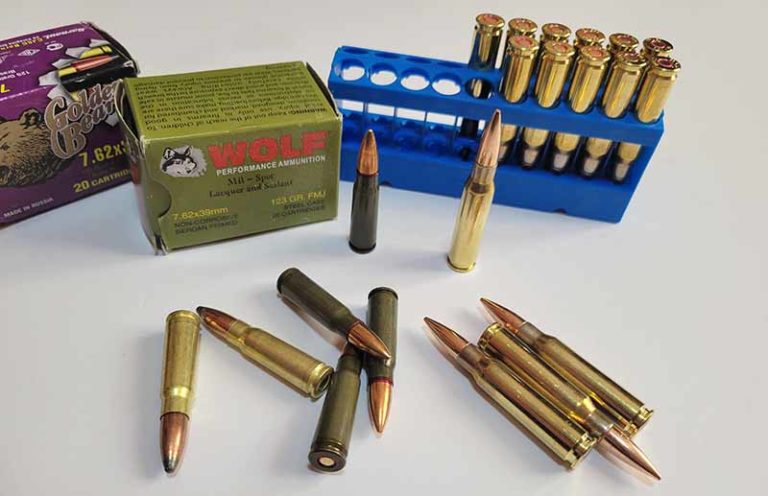
When it comes to 7.62×39 vs. .308 , which of the popular .30-cals has more to offer the average shooter?
Some may wonder, why even bother discussing 7.62×39 vs. .308 Winchester? The former is an intermediate cartridge, the latter a full-powered one. Even an amateur ballistician should understand these two cartridges have wildly different properties. What they do have in common, however, is still enough to warrant a comparison.
First, despite small differences between actual projectile diameters, both are .30-calibers. And second, their histories somewhat mirror each other, each rising to feed Soviet and NATO (in the guise of the 7.62x51mm) small arms during the Cold War.
Today, while neither NATO nor Russia uses infantry rifles chambered for these cartridges, both see military service worldwide. And luckily for the American shooter, both are still common, affordable and have a slew of firearm options available for them.
So, if you’re interested in diving into a new .30-caliber rifle, which of these cold warriors will serve you the best? Like so many guns and ammo questions, that depends on your ultimate aims.
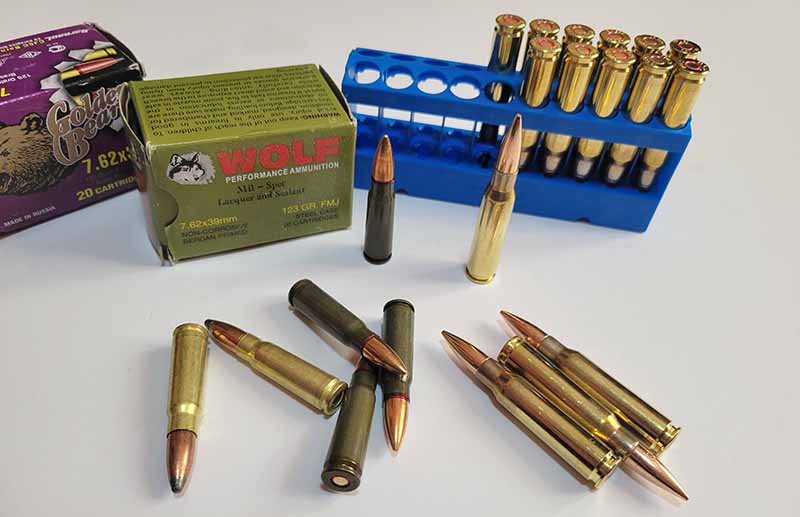
7.62×39 Development
Developed by the Soviet Union at the tail-end of WWII, 7.62×39 can be described as the world’s first truly refined intermediate cartridge. The Germans got the ball rolling with 8mm Kurz, but the concept wasn’t fully realized until the Russian M43 cartridge entered full-scale production and adoption in the late 1940s. It was planned for used in an entirely new family of weapons including the SKS, the RPD and the AK-47.
The fact the Soviets opted to retain the older, full-powered 7.62x54r for sniping and general-purpose machinegun roles should already tell a lot about 7.62×39's capabilities. While nearly perfectly suited for infantry rifles, light machineguns and “submachine guns” (as the AK was originally classified under Soviet doctrine), 7.62×39 just didn’t have the range or power necessary for the other two roles.
While officially replaced in Soviet service by the 5.45×39 cartridge in 1974, 7.62×39 is still in military use around the world, both by state and non-state actors.
In the U.S., the cartridge enjoyed a brief period of popularity for hunting use when SKSs, AKs and the ammo itself were being sold dirt-cheap in the 1990s. Today, it’s no longer commonly used in this capacity, however, the recent revival of interest in Kalashnikovs has ensured that 7.62×39 isn’t going anywhere any time soon.
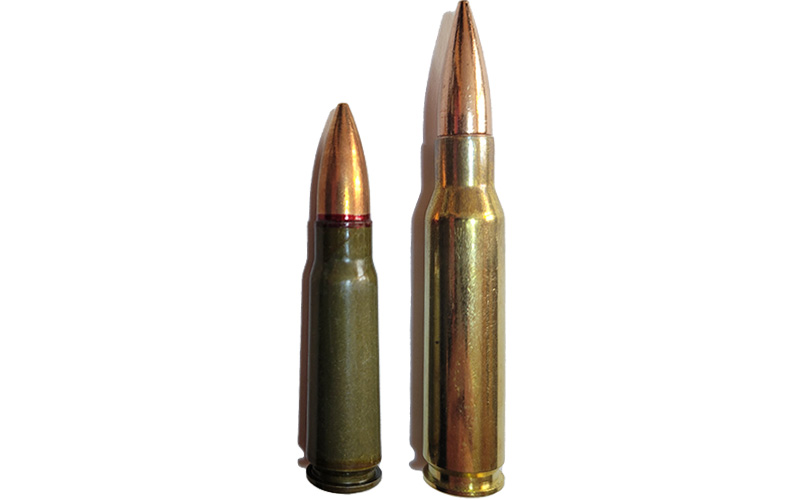
.308 Winchester/7.62×51 NATO
Because .308 Winchester and 7.62×51 NATO are so ballistically similar, for the purposes of this article we’ll be treating them as the same. Be aware, however, that the two cartridges are technically different.
Both completed development in the 1950s, making them slightly newer than 7.62×39. It’s hard to argue the West wasn’t behind the curve on this one. Squarely falling under the definition of a full-power cartridge for a standard infantry rifle, .308 and 7.62 NATO simply had more bite than was necessary.
This is partially why the U.S. was so quick to replace the M14 with the M16. Chambered for the intermediate .223 Remington/5.56×45 NATO cartridge, its adoption was undoubtedly inspired in concept by 7.62×39.
However, it’s also why 7.62×51 is still in NATO service today, just typically not in infantry rifles. Today, nearly 70 years after its initial adoption, 7.62 NATO is still a popular chambering for machine guns, sniper rifles and designated marksman rifles.
With this in mind, the best uses for both 7.62×39 and .308 start to become more apparent. While the former clearly has some close-contact advantages, the latter has much longer legs and barrier penetration capabilities. The only real questions then are how big is the gap in long-distance performance and how should that impact your choice in a cartridge?
7.62×39 Vs. .308 Winchester Ballistics
We’ll start with 7.62×39, as it's easier to discuss given its limited ammo options.
Virtually every load you find for this cartridge commercially in the U.S. features an FMJ projectile between 122 and 124 grains. These specs are almost identical to the Soviet M43 load, except for the original's steel core. Modern commercial ammo imports only have lead.
The original M43 bullet also featured a boat tail, something found on only some commercially available 7.62×39 today. While a historically accurate representation, opinions vary on just how much impact the inclusion of a boat tail has on this cartridge’s accuracy, given its … well … intermediate range. You also occasionally find hollow point, subsonic and soft point loads for this cartridge. Only the soft points, however, have any relevance to our present discussion.
Here’s a ballistic table for a standard Russian M43 122-grain 7.62x39mm FMJBT round (G1 BC of .304), calculated using a muzzle velocity of 2,411 fps (average for the SKS, a bit higher than the AKM due to a longer barrel).
All tables were made using ShootersCalculator with a 100-yard zero, 1.5-inch sight height, a 10 mph 90-degree crosswind and zero corrections for atmosphere.
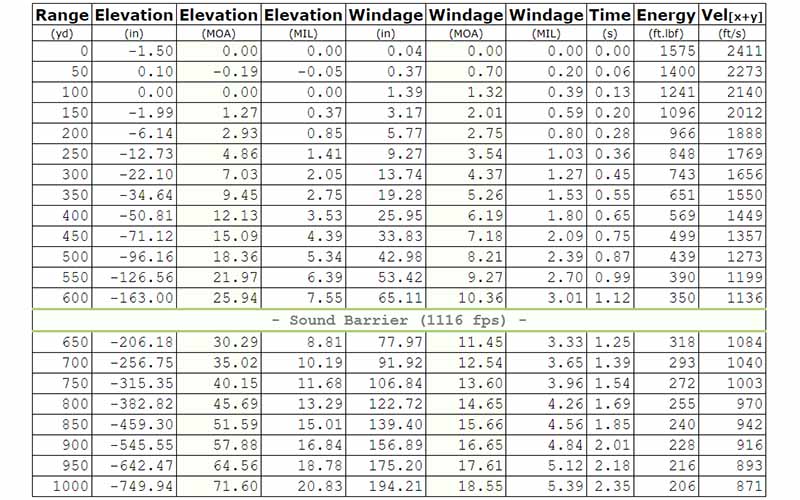
Next is a table for a fairly standard M80 load of 7.62×51 NATO made by Winchester, featuring a 149-grain bullet (G1 BC of .456) and an advertised muzzle velocity of 2,790 fps.

The tables make the differences between these two cartridges much more obvious. Not only does the standard 7.62 NATO round start its life with about 400 fps more muzzle velocity than 7.62×39, but it also has almost 1,000 foot-pounds more energy. The 7.62 NATO also doesn’t go subsonic until after 1,000 yards compared to 7.62×39 doing so just before 600 yards. At 1,000 yards, 7.62 NATO is still traveling at over 1,000 fps and has dropped nearly 400 inches less than 7.62×39 at the same distance.
Verdict? If you want any sort of long-range capability, the larger 7.62 is the clear winner. This is reinforced when comparing 7.62×39 to any sort of capable commercial .308 Winchester load rather than the mass-produced military M80 load of 7.62×51.
Here’s a table for Hornady’s 168-grain ELD Match load of .308 Winchester (G1 BC of .523) calculated using a muzzle velocity of 2,700 fps.
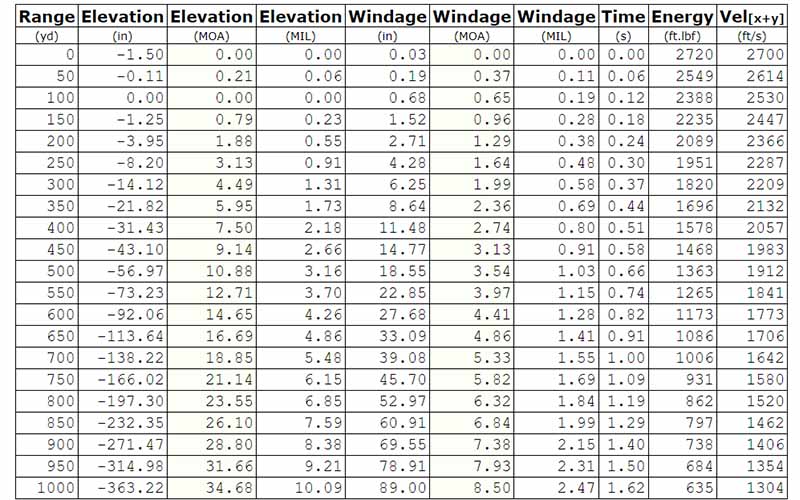
This load better demonstrates the true potential of .308 Winchester as a long-range cartridge, as all the areas where 7.62×51 outperforms 7.62×39 are further exaggerated. Namely, compared to the M80 load, the Hornady .308 Winchester has retained even more velocity and energy at 1,000 yards and has dropped about 10 fewer inches.
There is some 7.62×39 ammunition advertised as match-grade as well, but its performance still doesn’t rival .308 Winchester. For instance, GECO Target VM in 7.62×39 has a G1 BC of .355 which allows it to stay supersonic until just beyond 700 yards. For pushing the limits of this cartridge’s maximum range, loads like this are far superior to the standard spec but still fall short of even the most basic 7.62×51 ammo.
This difference in results stems from a few physical distinctions between the cartridges. The larger case of .308 Winchester allows for greater powder capacity, perhaps the defining feature in its longer legs. No matter the cartridge you’re discussing, more propellant equates to greater velocity and typically longer ranges among like calibers. Additionally, the .308’s projectiles are generally longer and heavier, giving them an overall superior ballistic profile.
Hitting targets at a country mile, however, isn’t the only factor to base a decision. So how do the .30-cals match up in what some might consider more practical applications?
7.62×39 Vs. .308 Winchester: Applications
Hunting
Given that both have been popular hunting cartridges in the U.S., perhaps a better comparison would be between their effects on targets within 400 yards. This leads us to another advantage of the .308 Winchester’s more common projectile: bullet variety.
Because SKSs aren’t $95 dollars any longer, the popularity of the 7.62×39 as a hunting option has dwindled in recent years. Ammunition manufacturers have responded to the lack of demand with fewer hunting-style soft-point and ballistic-tip bullets. There are some hangers-on, Sellier & Bellot and PPU still offer up hunting loads.
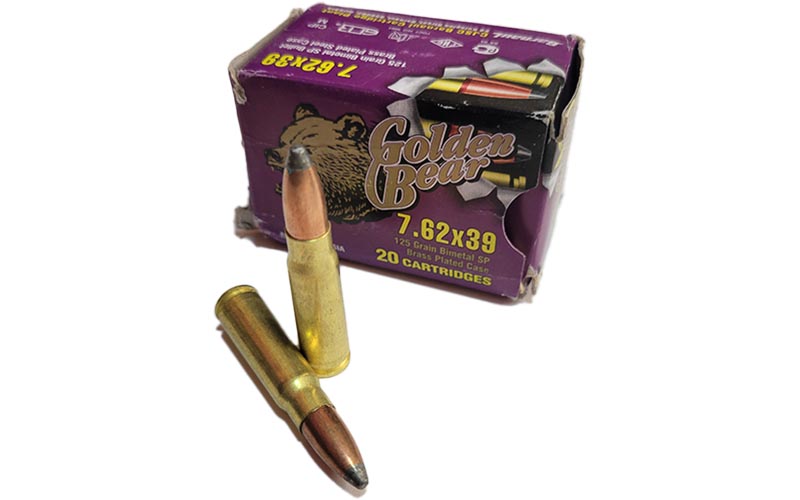
This is opposed to the nearly endless variety of loads available for .308 Winchester, both as factory ammo and reloading components. Whatever you’re trying to hunt, at least in North America, there is almost certainly a more efficient projectile for it in .308 as opposed to 7.62×39.
Defensive
Hunting is not the only use for ammunition, however, especially when military cartridges are in question.
You may debate between these two cartridges for a more tactical application such as home defense or a SHTF scenario. For that, 7.62×39 does have a clear advantage in most aspects.
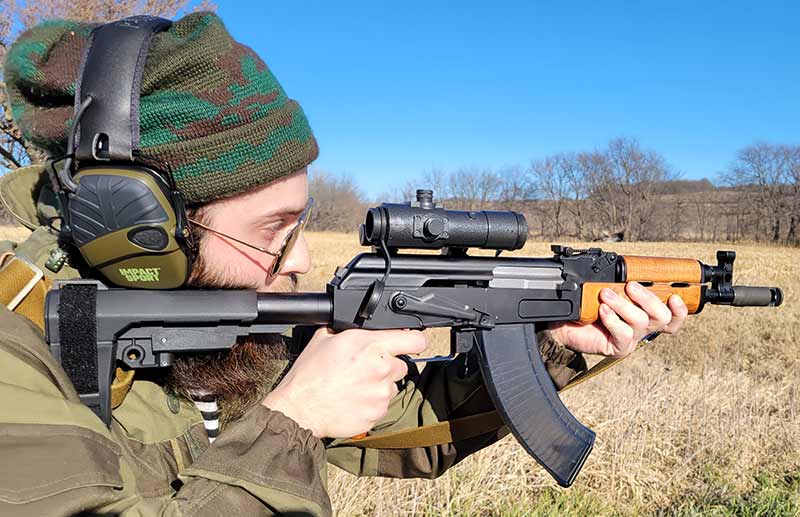
Chief among these is the cartridge’s generally milder recoil. This factor facilitates faster and more accurate follow-up shots and is one of the reasons most major militaries eventually made the switch from full-power to intermediate cartridges.
Capacity is another ace up the 7.62×39's sleeve, both of the weapons chambered for it and in an individual’s kit. When it comes to self-loading rifles, those chambered for .308 Winchester have a standard magazine capacity of 20 rounds. Those chambered for 7.62×39 are typically 30. Furthermore, the lighter ammo also enables one to carry much more on their person.
This is something to keep in mind if your intended application requires you to carry anything more than a single magazine.
7.62×39 Vs. .308 Winchester: Firearm Choices
On that note, your intended application should also be informed by the rifles available for each respective cartridge. Regardless of how you plan on using it, however, the .308 Winchester still wins in terms of firearm choice.
If hunting is your game, there are far more bolt-action rifles chambered for .308 than 7.62×39. There are still good options for the latter from companies like Ruger and CZ, but not nearly as many as there are for .308. That said, many deer have been taken with nothing more than a humble iron-sighted SKS. Not all hunting requires top-of-the-line gear.

For more tactical applications, there are still more options for .308. From military-pattern rifles like the HK G3 and FN SCAR to commercial AR-10 builds, you won’t be starved for choice. Of course, there are still many good 7.62×39 options as well. From the slew of different AK flavors on the market to 7.62×39 AR-15s, it isn’t hard to configure a modern fighting carbine for this cartridge either.
As mentioned, however, the milder recoil and lighter weight of 7.62×39 make it better suited for tactical and defensive use.
Parting Shot
So, which .30-caliber cold warrior will serve you best? The breakdown is about the same as it would be when pitting any full- and intermediate-power cartridges against each other. The full-power one provides better performance at range, has more varied projectile styles (generally) and delivers more energy with better penetration. The intermediate-power one offers milder recoil, is generally faster shooting and enables one to carry more ammunition.
At the end of the day, this makes the former better suited for most hunting applications and the latter better for most tactical uses. Accurate bolt-action hunting rifles and modern fighting carbines are available for both cartridges, however, so ultimately the choice is yours.
Raise Your Ammo IQ:
- Beyond The 6.5 Creedmoor: The Other 6.5 Cartridges
- Ammo Brief: The Versatile .243 Winchester
- .22-250 Ammo: Top 7 Loads For Any Purpose
- The Lonesome Story Of The Long-Lost 8mm
- Why The .300 H&H Magnum Still Endures
- .350 Legend Vs .450 Bushmaster: Does One Win Out For Hunting?

Next Step: Get your FREE Printable Target Pack
Enhance your shooting precision with our 62 MOA Targets, perfect for rifles and handguns. Crafted in collaboration with Storm Tactical for accuracy and versatility.
Subscribe to the Gun Digest email newsletter and get your downloadable target pack sent straight to your inbox. Stay updated with the latest firearms info in the industry.

![Best Concealed Carry Guns In 2025 [Field Tested] Wilson Combat EDC X9S 1](https://gundigest.com/wp-content/uploads/Wilson-Combat-EDC-X9S-1-324x160.jpg)


![Best 9mm Carbine: Affordable PCCs [Tested] Ruger Carbine Shooting](https://gundigest.com/wp-content/uploads/Ruger-Carbine-Shooting-100x70.jpg)
![Best AR-15: Top Options Available Today [Field Tested] Harrington and Richardson PSA XM177E2 feature](https://gundigest.com/wp-content/uploads/Harrington-and-Richardson-PSA-XM177E2-feature-100x70.jpg)

Check out the photo of the AK “pistol” and you wonder why the ATF banned them… the gun media does not help it’s own cause…
.30-06 any day over .308. 14% rule: 14% more power and 14% more recoil.